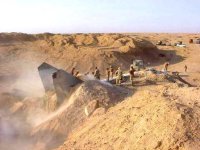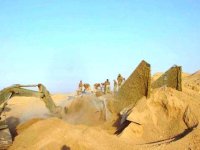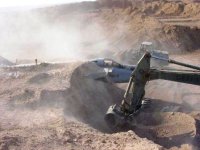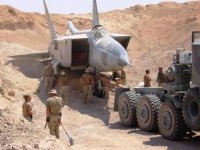jlbota
Gold Member
Wednesday, August 6, 2003
NewsMax.com has obtained exclusive photos of a buried Iraqi jet fighter being recovered by
U.S. Air Force troops. The Iraqi jet, an advanced Russian MiG-25 Foxbat, was found buried in the sand after an informant tipped off U.S. troops.
The MiG was dug out of a massive sand dune near the Al Taqqadum airfield by U.S. Air Force recovery teams. The MiG was reportedly one of over two dozen Iraqi jets buried in the sand, like hidden treasure, waiting to be recovered at a later date.
Contrary to what some in the major media have reported, not all the jets found were from the Gulf War era.
The Russian-made MiG-25 Foxbat being recovered by U.S. Air Force troops in the photos is an advanced reconnaissance version never before seen in the West and is equipped with
sophisticated electronic warfare devices.
U.S. Air Force recovery teams had to use large earth-moving equipment to uncover the MiG, which is over 70 feet long and weighs nearly 25 tons.
The Foxbat is known to be one of Iraq's top jet fighters. The advanced electronic reconnaissance version found by the U.S. Air Force is currently in service with the Russian air force. The MiG is capable of flying at speeds of over 2,000 miles an hour, or three times the speed of sound, and at altitudes of over 75,000 feet.
The recovery of the advanced MiG fighter is considered to be an intelligence coup by the U.S. Air Force. The Foxbat may also be equipped with advanced Russian- and French-made electronics that were sold to Iraq during the 1990s in violation of a U.N. ban on arms sales to Baghdad.
The buried aircraft at Al Taqqadum were covered in camouflage netting, sealed and, in many cases, had their wings removed before being buried more than 10 feet beneath the Iraqi desert.
X Marks the Spot
The discovery of the buried Iraqi jet fighters illustrates the problem faced by U.S. inspection
teams searching Iraq for weapons of mass destruction. Iraq is larger in size than California, and the massive deserts south and west of Baghdad were used by ****** Hussein to hide weapons during the first Gulf war.
U.S. intelligence sources have already uncovered several mass grave burial sites in the open deserts with an estimated 10,000 dead hidden there. In addition, Iraq previously hid SCUD
missiles, chemical weapons and biological warheads by burying them under the desert sand.
U.N. inspection teams found the weapons in the early 1990s after detailed information of the exact locations was obtained.
Top U.S. weapons inspector Dr. David Kay is known to favor human intelligence as the primary means to find Iraq's hidden treasure trove of weapons and secrets.
While there are rumors of Iraqi chemical and biological weapons being shipped to nearby Syria, the weapons may very well still remain inside Iraq buried under the vast desert wastelands.
Hmmmmmmmmmmmm. I wonder if there is still more to come?
NewsMax.com has obtained exclusive photos of a buried Iraqi jet fighter being recovered by
U.S. Air Force troops. The Iraqi jet, an advanced Russian MiG-25 Foxbat, was found buried in the sand after an informant tipped off U.S. troops.
The MiG was dug out of a massive sand dune near the Al Taqqadum airfield by U.S. Air Force recovery teams. The MiG was reportedly one of over two dozen Iraqi jets buried in the sand, like hidden treasure, waiting to be recovered at a later date.
Contrary to what some in the major media have reported, not all the jets found were from the Gulf War era.
The Russian-made MiG-25 Foxbat being recovered by U.S. Air Force troops in the photos is an advanced reconnaissance version never before seen in the West and is equipped with
sophisticated electronic warfare devices.
U.S. Air Force recovery teams had to use large earth-moving equipment to uncover the MiG, which is over 70 feet long and weighs nearly 25 tons.
The Foxbat is known to be one of Iraq's top jet fighters. The advanced electronic reconnaissance version found by the U.S. Air Force is currently in service with the Russian air force. The MiG is capable of flying at speeds of over 2,000 miles an hour, or three times the speed of sound, and at altitudes of over 75,000 feet.
The recovery of the advanced MiG fighter is considered to be an intelligence coup by the U.S. Air Force. The Foxbat may also be equipped with advanced Russian- and French-made electronics that were sold to Iraq during the 1990s in violation of a U.N. ban on arms sales to Baghdad.
The buried aircraft at Al Taqqadum were covered in camouflage netting, sealed and, in many cases, had their wings removed before being buried more than 10 feet beneath the Iraqi desert.
X Marks the Spot
The discovery of the buried Iraqi jet fighters illustrates the problem faced by U.S. inspection
teams searching Iraq for weapons of mass destruction. Iraq is larger in size than California, and the massive deserts south and west of Baghdad were used by ****** Hussein to hide weapons during the first Gulf war.
U.S. intelligence sources have already uncovered several mass grave burial sites in the open deserts with an estimated 10,000 dead hidden there. In addition, Iraq previously hid SCUD
missiles, chemical weapons and biological warheads by burying them under the desert sand.
U.N. inspection teams found the weapons in the early 1990s after detailed information of the exact locations was obtained.
Top U.S. weapons inspector Dr. David Kay is known to favor human intelligence as the primary means to find Iraq's hidden treasure trove of weapons and secrets.
While there are rumors of Iraqi chemical and biological weapons being shipped to nearby Syria, the weapons may very well still remain inside Iraq buried under the vast desert wastelands.
Hmmmmmmmmmmmm. I wonder if there is still more to come?



